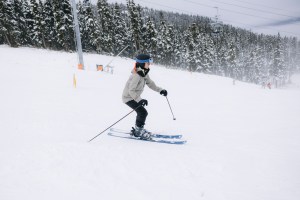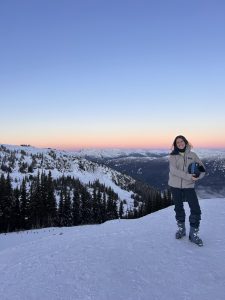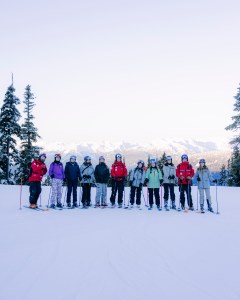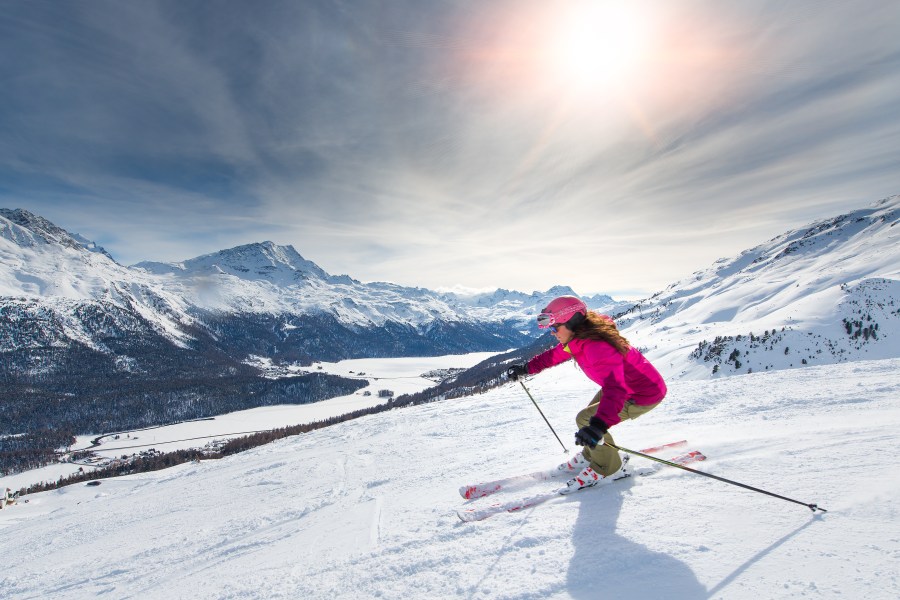Although skiing is fun, the slopes can be dangerous if you don’t know what you’re doing. Lucy Gornall takes a look at how you can stay safe on your ski season this year.
So you’ve booked your ski trip- whether it’s for this ski season or next year – and it’s safe to say, you’re excited. But, before you zip up your jacket and click on your skis, it’s a good idea to get up to speed on how to stay safe on the slopes.
After all, being out in the mountains, whether you’re skiing alone or with friends, can be dangerous and there are several things to be aware of before you go zipping down the runs.
In honour of National Ski Patroller day on February 10th, we spoke to Sarah Reade, a ski patroller at Whistler Blackcomb in Canada for her advice on making sure your ski trip is safe and stress free.

Know Your Runs
Not sure what runs to ski on? It’s best to stick to groomed runs as Sarah says these are nicer to ski on, and safer. Groomed runs tend to also have consistent snow and will be cleared of trees.
“On groomed runs, hazards are marked and there are signs,” says Sarah.
As for the level of difficulty of a run, green runs are the easiest, blue runs are aimed at intermediates, red runs are advanced, and black runs are very difficult.
Sarah explains that skiing off-piste involves choosing your own run and ultimately, your own adventure.
If you want to ski off-piste, which goes beyond the marked runs but within resort boundaries, Sarah suggests booking a ski lesson where you can ask to be taken off-piste skiing to get your bearings.
“Your instructor will teach you how to ski off-piste safely. Even if you’re a pretty good skier, the tips on how to do it better are invaluable. They’ll also be a local who knows where the good snow will be and where the good runs will be,” says Sarah.
Learn The Basic Rules
Much like it’s required to learn The Highway Code before driving safely (and lawfully) on UK roads, it’s a good idea to read through the Alpine Responsibility Code before hitting the slopes.
Sarah says that there are some easy-to-remember rules which everyone needs to abide by when skiing or snowboarding.
“When you’re on the slopes, people below you or ahead of you have right of way,” says Sarah.
There are no lanes on the slopes, so you may not be aware of which direction people plan to go in. This means you need to be prepared for all eventualities. Staying in control is another important rule to remember, and this can help to avoid collisions should you wrongly judge which way someone is going in front of you.
“When stopping on the slopes, stop where you can be seen from above,” says Sarah. So, avoid stopping in front of bumps in the snow, as people behind you won’t be able to spot you.
Sarah also adds: “When resting on the slopes, standing is better than sitting if you’re a skier. As for snowboarders, the safe direction to stop and rest is kneeling, facing uphill. With your back to the slope, you can’t see anything. And check uphill before skiing down again.”
First time skiing? Check what ski gear and kit you’ll need to buy.

Give Space To Trees
The edges of ski runs tend to be littered with big evergreen trees, covered in crisp snow. But whilst these trees make a beautiful backdrop for photos, they can be extremely dangerous.
Sarah explains that deep snow and fresh powder can cause a ‘tree well’; this is a deep area around the base of the tree filled with loose snow.
“Branches of the tree stop the snow from reaching the tree base so a well is formed. If you get too close to this well you can fall in,” explains Sarah who adds that you could fall in upside down and as you thrash around trying to escape in a hole of fluffy, powdery snow, more snow falls on top of you which can cause suffocation.
“Stay on a groomed run and you’re good. Leave a healthy gap between you and the tree if you’re skiing down a run with trees and ski with a buddy in sight,” adds Sarah.
“Every year we have people who have pulled their friends from ski wells.”
Stay Safe When You’re Alone
Keen for some solo ski? Sarah says it’s better to ski with friends, however if you are alone, ‘make sure you know how to contact help.
“If you have a phone to call from, that’s the best way. You can also ask any liftie (a member of staff working on the ski lifts) or staff member to call ski patrol.
“Have a map with you and know where you are and where you want to go. “Preventative safety is the best – choose runs that are suited to what you want to ski and always tell someone where you are,” says Sarah.
If you’re with a group of people and you end up getting lost, then Sarah says ski patrollers can help find you.
But, she suggests having a plan beforehand so you know what to do if you get separated. You may choose to regroup at a lift or at the bottom of the slope.

Wear The Right Clothing
Although it’s not a law, wearing a helmet when you ski is strongly recommended, according to Sarah.
“Kids in ski lessons are lawfully required to wear a helmet, but for anyone else, it’s up to your own discretion. But as someone who sees a lot of injuries, I highly recommend wearing one,” says Sarah.
“Wear warm enough clothes, proper gloves, and high protection goggles,” adds Sarah. With your goggles, look for 100% UV protection, and make sure the goggles you choose fit snugly around your face to prevent wind, sun and snow from entering.
Sarah also recommends good quality base layers with sweat wicking technology to help keep you cool and dry.
Be Ski Fit
Ensuring you’re ski fit before heading off on your ski holiday can not only help you to have the stamina and strength needed for a comfortable ski, but it can also help with injury prevention, so you can hit the slopes every day without feeling sore.
Regular cardio is important to ensure your heart and lungs stay strong and can handle consistent movement
Sarah adds: “Some ski specific things I do as I go into ski season include squats and squat jumps for leg strength as well as eccentric leg work, which is super key for skiing for longevity and endurance.”
Eccentric exercises focus on movement that lengthens the muscle. This could be lowering into your squat, or running downhill.
Sarah also recommends building up your core strength; after all, a strong core can help you stay stable and balanced as you ski or snowboard, which can help reduce your chances of falling.
Sarah also adds that she does plyometric exercises, which tend to involve jumping as these can help build power in the lower body.
Be sure to fuel your ski session too
“Make sure you’ve had a good breakfast before you ski and you’re hydrated. Pack snacks in case you get tired. Think of a day of skiing as a big workout day,” says Sarah.








